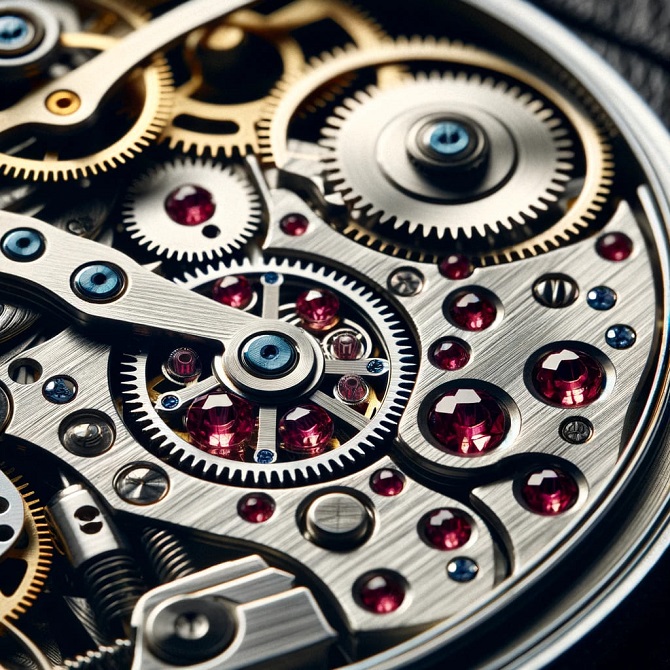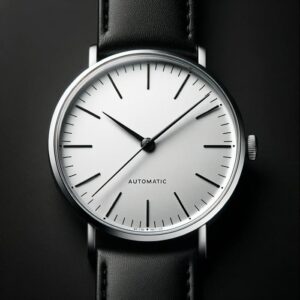What Are Jewels Used for in a Watch?

In the realm of horology, mechanical watches have undergone a remarkable evolution, transitioning from simple timekeeping devices to intricate examples of craftsmanship and precision engineering. Central to this evolution has been the innovative incorporation of jewels, such as synthetic rubies and sapphires, within watch mechanisms. These jewels are not mere embellishments but serve a critical functional purpose - as bearings that significantly reduce friction and wear among the moving metal parts. This strategic placement not only enhances the durability of the watch but also greatly improves its timekeeping accuracy. The advent of synthetic jewel manufacturing has further democratized this feature, making the benefits of jewel incorporation accessible across a wider range of timepieces. As a testament to both tradition and technological advancement, the use of jewels within watch mechanisms exemplifies the industry's ongoing commitment to precision, reliability, and excellence in craftsmanship.
Historical Context
The use of jewels in watchmaking dates back to the 1700s, pioneering an era where the quest for precision in timekeeping saw remarkable innovations. Initially, jewels such as diamond and sapphire were rarities, embedded within watches as indicators of luxury and exclusivity. This practice, however, gradually evolved from mere ornamentation to a standard mechanism in enhancing the functionality of watches. The incorporation of synthetic rubies, developed as an affordable yet effective substitute for natural gemstones, marked a significant milestone in the democratization of jeweled watches.
Famous watchmakers played pivotal roles in this evolution. Their contributions not only refined the craft but also underscored the importance of jewels for their practical benefits—reducing friction and wear within the movement, thus improving accuracy and longevity. These watchmakers' innovative thinking and dedication to precision led to the widespread acceptance and implementation of jewel bearings, making them indispensable elements in both mechanical and higher-end automatic watches. Through their efforts, jeweled watches transitioned from the epitome of luxury to a hallmark of quality and precision in timekeeping.
The Significance of jewels in watchmaking
Jewels in watches serve a critical functional role far beyond their visual appeal, acting as bearings for gears and other moving parts. These tiny, yet durable elements are strategically placed within the watch's movement, particularly in high-friction areas such as the balance wheel pivots and escapement mechanisms. This placement is instrumental in ensuring the smooth operation of these components, thereby enhancing the watch's overall performance and longevity.
The types of jewels most commonly employed include synthetic rubies, sapphires, and, less frequently, diamonds. These materials are chosen for their exceptional hardness and resistance to wear. Synthetic rubies and sapphires, varieties of corundum, are especially favored for their ability to withstand the rigors of constant movement within the watch mechanism, reducing friction and preventing premature wear on metal parts. This contributes significantly to maintaining the precision of the timekeeping mechanism, ensuring that mechanical and higher-end automatic watches can offer the accuracy and reliability expected by users. Through their material properties and meticulous placement within the watch movement, these jewels play an indispensable role in the art and science of horology.
Benefits of jewels in watchmaking
The integration of jewels within watch mechanisms presents a multitude of benefits that significantly enhance the craftsmanship and performance of timepieces. The primary advantage lies in the substantial reduction of friction and wear between metal parts. By serving as hard, smooth surfaces on which the gears and other moving components operate, jewels like synthetic rubies and sapphires minimize the direct metal-to-metal contact, thus extending the watch's lifespan.
This reduction in friction also contributes to the improved accuracy of timekeeping. With jewels ensuring a smoother and more consistent movement, watches can maintain their precision over longer periods, reducing variations in timekeeping that are often caused by wear and tear on the mechanical parts. Furthermore, the durability of these jewels decreases the watch's maintenance needs. Their ability to withstand the rigors of daily wear means that jeweled watches require servicing less frequently compared to their non-jeweled counterparts, making them not only more reliable but also more cost-effective in the long run. These benefits underline the significance of jewels in elevating the art of watchmaking to new levels of precision and longevity.
The number of jewels in watches
The number of jewels within a watch is often seen as a testament to its complexity and functionality. This count, typically ranging from 5 in basic models to over 30 in more sophisticated timepieces, directly corresponds to the intricacy of the watch's movement. More jewels indicate a higher number of pivot points that require bearing surfaces, suggesting a greater level of mechanical complexity designed to enhance the watch's precision and durability.
However, a common misconception equates a higher jewel count with superior quality or value, which isn't always the case. The optimal number of jewels depends on the specific requirements of the watch's movement and its intended functionality rather than serving as a universal indicator of excellence. For instance, a standard 17-jewel mechanical watch is considered "fully jeweled" for most basic timekeeping functions, providing a balance between efficiency and cost. In contrast, luxury or highly specialized watches may boast a greater number of jewels to support additional features and complications, such as chronographs and perpetual calendars, signifying a higher level of craftsmanship and complexity.
Understanding the purpose and placement of jewels within different watches helps demystify their role, highlighting that the true value of a timepiece lies not merely in its jewel count but in the precision and care with which it was crafted.
| Jewel Count | Functionality & Complexity | Typical Features | Perceived Value |
|---|---|---|---|
| 5 jewels | Basic models | Minimal functions; basic timekeeping | Often perceived as lower quality/value |
| 17 jewels | Standard "fully jeweled" | Sufficient for most basic timekeeping functions; balance between efficiency and cost | Considered efficient and cost-effective |
| Over 30 jewels | High complexity | Additional features and complications (e.g., chronographs, perpetual calendars); higher level of craftsmanship | May signify luxury and higher craftsmanship, but not always superior quality |
Modern advances and innovations
Modern advances in the manufacturing of synthetic jewels have significantly impacted the watchmaking industry, both in terms of accessibility and innovation. The advent of lab-created rubies and sapphires has democratized the use of jewels, allowing for their widespread application across various price points without compromising on the quality and durability these stones provide. This development has opened new avenues for watch design and functionality, enabling watchmakers to explore complex mechanisms that require a higher number of friction-reducing bearings without significantly increasing costs.
Innovations in watch design now often incorporate jewels not just for their traditional role in reducing wear and improving accuracy but also for enhancing the aesthetic appeal and value of timepieces. As the industry continues to evolve, the potential for new materials and applications appears boundless. Research into harder and more wear-resistant materials could lead to the discovery of alternatives to corundum-based synthetic jewels, further revolutionizing the mechanics of watchmaking. Additionally, the application of nanotechnology and advanced material science could introduce novel ways to capitalize on the unique properties of jewels, pushing the boundaries of precision, durability, and design in future timepieces.
Conclusion
In conclusion, the incorporation of jewels into watch mechanisms is not just a nod to the opulence of antiquity but a testament to the relentless pursuit of precision and durability in timekeeping. This article delves into the intricacies of watchmaking, highlighting how synthetic rubies and sapphires, serving as jewel bearings, significantly reduce friction and enhance the functionality of mechanical and higher-end automatic watches. Emphasizing the role of jewels transcends mere aesthetics, emphasizing their critical function in ensuring the smooth operation and longevity of the watch's movement. As we appreciate the seamless blend of tradition and cutting-edge technology in modern watchmaking, it becomes evident that the ancestral art of jeweled timepieces is very much alive, continually refined by innovations in material science and craftsmanship. This blend not only preserves the historical essence of horology but also drives it forward, encouraging a deeper appreciation for the meticulous engineering and craft behind each jeweled watch. The artistry and innovation evident in the placement of jewel bearings reveal a fascinating layer of watchmaking, inviting enthusiasts to marvel at the precision that defines the essence of luxury and functionality in timekeeping.
